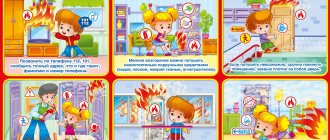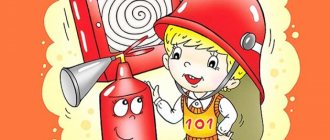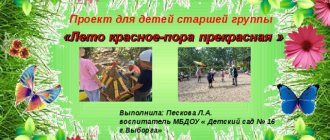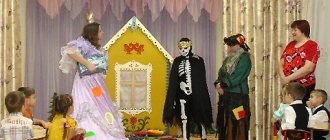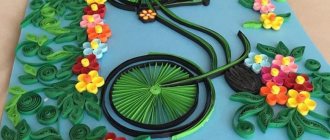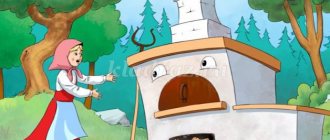Summary of entertainment according to traffic rules “Summer of Safety” for the senior group
Entertainment for older children
according to traffic rules
"Summer of Safety"
The date of the:
August 9, 2021
Target:
Formation of knowledge, skills and practical skills of safe behavior on the road and street.
Tasks:
- To consolidate children's knowledge about transport and types of transport.
- Strengthen your knowledge of road signs with your children.
- Strengthen children's knowledge about traffic lights.
Material:
traffic light, ball, rod, road signs.
Educator
: Guys, today we will find out how well you know the rules of the road, road signs and traffic lights.
The color red tells us
There is no further road for you,
The yellow color gave us a signal
Get ready said
And the green one blinked
The way is clear, he told us.
Educator
: Guys, who gives signals to pedestrians and vehicles about actions on the road?
Children
: traffic light.
Educator:
And now guys, we will find out how dexterous, fast, attentive you are and how well you know traffic lights and road signs.
1st stage WARM-UP “TRAFFIC LIGHTS”
(
children disperse to the music, at the signal - the traffic light shows a red circle - they stand, a yellow circle - they crouch, a green circle - they march)
Educator:
We'll play autodrome-
the rules are like this,
snake around the pins
hand over the steering wheel to someone else.
Stage 2 “Behind the wheel!”
Participants are asked to run along the track as quickly as possible, passing the steering wheel and holding it in front of them with both hands.
Stage 3 “CAMOMILE”
Team captains take turns tearing petals off a paper daisy and answering questions in a commanding manner.
— When you walk along the sidewalk, who are you? (pedestrian) - How many signals does a pedestrian traffic light have? (Three) - What is a zebra? (Pedestrian crossing) - Name the special purpose vehicles. (DPS; ambulance; fire department; Ministry of Emergency Situations...) - What is the name of the place where we are expecting a vehicle? (stop) - What is a roadway? (part of the road along which people move) - What types of pedestrian crossings do you know? (ground, underground) - What do you call people walking down the street? (pedestrians) - Which traffic light is allowed to cross? (green)
Stage 4 “Pedestrian crossing”
A white or yellow stripe is hung on the back of the participants. Participants must lie on their stomachs to create a pedestrian crossing.
Educator:
The street is full of surprises
If you forgot the rules,
And you won’t remember them at all
It will help you along the way
A good friend is a road sign!
Stage 5: “Find the road sign.”
The teacher reads out why this or that sign is needed, the children look for a sign that matches the description.
• I want to cross the street, what road sign should I look for to determine where to cross? (pedestrian crossing sign) • We went on vacation outside the city and wanted to eat. What sign will help us find the dining room? (sign "food place")
• Our car broke down. By what sign can we determine where it can be repaired? (service station sign) • We are out of gas. By what sign will we determine where we can refuel? (gas station sign) • We need medical help. By what sign can we determine where we can find a first aid station or a hospital? (sign “medical assistance”) • This sign is very strict, since it is located on the road. He tells us: “Friends, you can’t drive here at all!” (no traffic sign) • Drivers prohibited sign, cars are prohibited from entering! Don't try rashly, drive past the brick! (no entry sign) • Overtaking sign. Outlaws. In this place, it is immediately clear that overtaking others is dangerous! (no overtaking sign)
Stage 6 “CAUTION CHILDREN”
(with a ball)
hitting the ball on the floor, run to the tunnel, crawl along it, run around the counter, go around it and return
Educator:
Look, what a strong man, He’s used to stopping a five-ton truck on the move with one hand. (Adjuster)
Stage 7 “PASS THE WAND”
Everyone stands in a circle, music sounds, children pass the baton around in a circle, when the music stops, the one who has the baton calls the road sign.
Stage 9 “Fold the sign”
from parts
(two envelopes with signs) Fold a sign cut into pieces faster and correctly.
Educator:
Guys, you all tried your best and showed good results. And now we will all say our motto together and in unison:
Children in chorus:
Remember all the signs
Road traffic,
Now we will walk
Always without complications.
Street
A road that runs through a city or town is called a street. It has a roadway along which cars move. Sometimes the roadway is divided by a strip of green space - a boulevard into two parts, two lanes.
Along the edges of the roadway there are strips covered with asphalt - these are sidewalks. Pedestrians move along them. The sidewalk rises slightly above the roadway; This is done in order to clearly define the boundary between the roadway and the sidewalk.
On some streets, where there are especially many pedestrians, the sidewalk is fenced off from the roadway with metal barriers - they prevent pedestrians from unexpectedly entering the roadway, which is very dangerous. No pedestrians have the right to climb over the fence.
Streets on the roadway of which cars move in two directions: on one side in one direction, and on the other in the opposite direction, are called two-way streets. Streets where traffic flows in one direction are called one-way streets.
There are streets that run parallel to each other, and there are streets that intersect. The place where they intersect is called an intersection.
- What is a street?
- Where should a pedestrian walk?
- Is it possible to climb over metal sidewalk barriers to cross the street?
- In which direction do cars move on a two-way street?
- What is the name of the intersection of streets?
We are pedestrians
A pedestrian
All people who move along the street on foot (persons driving a bicycle are considered the same) are called pedestrians.
Most of the traffic on streets and roads is pedestrians. Even drivers, when they get out of their cars, for some time join the great army of pedestrians. For many centuries, pedestrians were left to their own devices to determine the safety of pedestrians and establish traffic rules for them. Now they have been introduced in all countries of the world, every pedestrian, young and old, must know them. Repeat with children.
Basic rules for pedestrians.
- Pedestrians must move along the roadway on sidewalks or pedestrian paths.
- Walk only on the right side of the sidewalk.
- If you meet an acquaintance, then in order to talk, step aside with him.
- If you are walking with your friends, then do not block the road, lining up in a line of 3-4 people.
- When waiting to cross, never stand on the edge of the sidewalk.
- You need to cross the street in places where there is a pedestrian path.
- You need to cross the road when the traffic light is green, only after you are sure that the cars have time to brake and stop.
- Do not cross the roadway diagonally, but only strictly straight.
- Before crossing the road, you need to look left, right and make sure that the transport is far enough to cross the road.
- Small children are held by the hand when crossing the street.
- When moving along the crossing, you must be careful, without stopping, without interfering with other pedestrians, and without sticking to the right side.
- You need to wait for route transport at specially equipped places - stops.
- Do not push passers-by when rushing to the bus.
- You cannot play next to or on the roadway.
- You cannot go out onto the road because of stopped vehicles or because of bushes.
- You cannot suddenly appear in front of nearby traffic.
- Always remember that not only your life, but also the safety of others depends on your behavior on the street.
- What do you call people walking along the street?
- Who is the sidewalk for?
- Which side of the sidewalk can you walk on? Why?
- Where are pedestrians required to cross the street diagonally?
- Where should I wait for shuttle transport?
- Why can’t you suddenly appear in front of nearby traffic?
- Why can't I play next to or on the roadway?
We and transport.
Transport
The word “transport” was introduced into the Russian language by Tsar Peter the Great. When he compiled the first Russian Maritime Charter (rules for military sailors) in 1720, he called ships for transporting goods “transports.” The king borrowed this word from the German language. And the Germans took it a long time ago from Latin, which was spoken by the ancient Romans. It meant “to carry”, “to move”. The word quickly took root among us; no one considers it foreign anymore. True, its meaning has changed over time. We now call transport not only cargo ships, but also other equipment for transporting goods and passengers.
Transport can be water, air, land (rail, road). We see cars, buses, and trucks on the streets every day. And we don’t just see - we cross the roads along which they rush, we drive in them. When people travel in transport, they are called passengers. Repeat with children.
Basic rules for passengers.
- You need to wait for route transport at specially equipped places - stops.
- When you are waiting for transport, do not stand on the very edge of the sidewalk: you can trip or slip in winter and get hit by a wheel.
- Enter and exit public transport from the front.
- While driving, you cannot touch the doors with your hands until the driver opens them.
- When you enter, do not forget about those who come after you, behave correctly and calmly.
- If you are sitting, give your seat to someone older than you. Boys always give way to girls.
- Don't forget that there are passengers standing and sitting around you. Don't scream when talking to a friend, don't laugh loudly, don't wave your arms, don't stand on the seat with your feet, don't chew ice cream or pies - you can dirty those around you.
- While driving, do not get up from your seat or move around the bus. If you make a sharp turn or stop suddenly, you may fall and get hurt.
- Don't stick your head or hand out of the window. Passing traffic may hit you, causing serious injury.
- You cannot talk or distract the driver while driving.
- After getting off the bus, you need to go to the pedestrian crossing and only cross the street there.
Ask the children:
- What types of transport do you know?
- Why can't you stand on the edge of the sidewalk when you're waiting for transport?
- Where do you expect shuttle buses?
- Is it possible to talk to the driver while driving?
- Is it allowed to walk on the bus while it is moving?
- Why can't you put your feet on the seat?
- Is it possible to talk loudly, shout, wave your arms, or eat ice cream on the bus? Is it possible to touch the doors of a bus while it is moving?
Rules of behavior during seasonal weather changes.
Attention! Winter came…
Snow fell and everything around changed. And trees, and houses, and roads. Everyone rejoices at the coming of winter. You can play snowballs, make a snow woman, go sledding and skiing.
Frost and sun - a wonderful day! But …
- In winter, there is a danger of injury due to ice. Therefore, you need to step on your entire foot, walking in small steps, slowly, with your legs slightly relaxed at the knees.
- The roads have become slippery, you need to be careful when crossing them - you can fall.
- It is difficult for the driver to stop the car, and with sharp braking it can skid onto the sidewalk.
- When it snows, raised collars, large hoods that cover the face, foggy glasses, a hat pulled down too far, a collar that is too high - all this hinders traffic and prevents pedestrians from inspecting the road. Because of this, you may not notice an approaching car.
- The car windows are covered with snow and the driver has difficulty seeing pedestrians and traffic lights.
- Do not play in the snow on the sidewalks, roadways, or roads.
- Do not sled, ski or skate on sidewalks, near or on roads.
- Don't cling to the bumper of a passing car. Not only your life, but also the safety of others depends on your behavior on the street.
- What precautions should be taken during icy conditions?
- Why is it difficult for a driver to stop a car?
- Where should you play, ski and sled?
- Why can't you cling to the bumper of a car?
